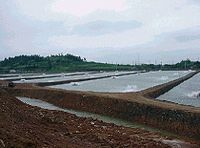
Photo from wikipedia
Abstract The production of shrimp is often performed in earthen outdoor ponds in which the input of feed and faeces on the bottom results in deterioration of the water quality… Click to show full abstract
Abstract The production of shrimp is often performed in earthen outdoor ponds in which the input of feed and faeces on the bottom results in deterioration of the water quality that results in a negative impact on the aquatic animals and the environment. Nitrate application in shrimp ponds could improve pond water and sediment quality by oxidizing anaerobic zones of the sediment. This study was conducted to evaluate the possible benefits of nitrate treatment in combination with probiotics application to decrease sulphide formation in shrimp ponds, which is a crucial problem during the growth phase of shrimp. Three sets of experiments were conducted to describe the mechanism of nitrate treatment: a dual dose nitrate treatment at the start and after 14 days that investigated nitrate treatment with concentrations of 50, 100 and 200 mg/L NO3−, a multiple dose nitrate treatment where lower doses of nitrate (12.5, 25 and 50 mg/L NO3−) were tested with more frequent application (every 4 days) and a microbially assisted nitrate treatment in which 50 mg/L NO3− treatment was applied every 4 days with and without presence of a single probiotic application. A batch system including shrimp feed and faeces, representing the bottom waste produced during 90 days of shrimp culture, was used to test the effect of nitrate addition under anaerobic conditions that mimic the dead zones in shrimp pond bottoms where high amounts of organic matter accumulate. Nitrate addition acted as a curative solution for hydrogen sulphide (H2S) accumulation, rather than preventive. Nitrate amended treatments (12.5 mg/L.day NO3) decreased the accumulated H2S in the headspace of incubation bottles by 93 ± 3% compared to the controls. Nitrate addition increased pH and decreased organic acids accumulation to trace amounts. To justify the decrease in H2S concentration apart from the effect sulphur speciation through pH increase, a separate test was conducted to compare the effect of NaOH with nitrate treatment, in which nitrate treatment resulted in a 62.8% higher decrease in H2S concentrations than the NaOH treatment. The use of a denitrifying strain did not improve the beneficial effect of nitrate, indicating that intrinsic capacity for anoxic conversion of waste by the present community was sufficient. In conclusion, nitrate treatment showed a potential to control H2S accumulation in the shrimp ponds that is a critical problem during the growth of shrimp.
Journal Title: Aquaculture
Year Published: 2020
Link to full text (if available)
Share on Social Media: Sign Up to like & get
recommendations!